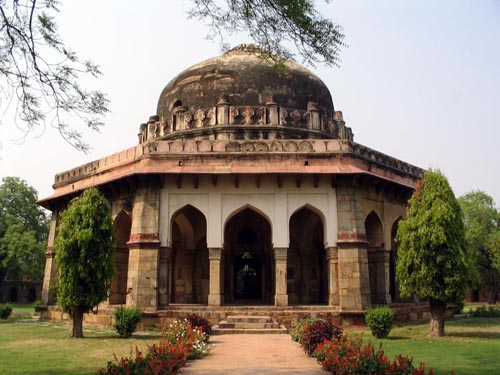Sikandar Lodi Tomb

Information on Sikandar Lodi Tomb (New Delhi) - History & Architecture
Lodi Garden is known to be scattered with structures during the Lodhi and Sayyid Periods and consists of mosques, tombs and bridges. The Lodhi Gardens is an eminent park situated in Delhi and involves an area of more than 90 acres. It is known to house prominent architectural works prevalent during the 15th century by an Afghan dynasty, the Lodhis which includes Sikander Lodi's Tomb, Mohammed Shah's Tomb, Bara Gumbad and the Sheesh Gumbad. The Afghan dynasty that is the Lodhis reigned over the regions of Punjab, northern India along with the region of Khyber Pakhtunkhwa from the period of 1451 to 1526. The Lodhi Gardens is considered be an imperative historical site and is therefore, presently looked after by the archaeological Survey of India (ASI).
Sikandar Lodi Tomb Architecture
The tomb of Sikander Lodhi was erected by his son named Ibrahim Lodhi in the year 1517. Ibrahim Lodhi is known to be the last Sultan who reigned Delhi from the Lodhi dynasty. The mausoleum of Sikander Lodhi is octagonal is shape and has been built according to the Mughal style of architecture along with a hint of Sayyid architectural design as well. The tomb of Sikander Lodhi is considered to be a structure reflecting the signs of recommencement with regard to the Sayyid form of architecture which includes eight sides, tall semicircles and profound verandahs. The tomb walls include various Mughal designs along with the inscriptions in several foreign languages which makes it increasingly exceptional. The tomb is placed on a lofty platform with a series of steps. The octagonal chamber or rather the grave of Sikander Lodhi is encircled with running verandahs the sides of which are perforated by three curves or arcs along with slanting structures occupying the angles. The mausoleum of Sikander Lodhi is enveloped with lush verdant, well cared flora along with huge trees. The mausoleum in other words is surrounded with garden which is supposed to be amongst the best Asian gardens.
Sikandar Lodi Tomb History
Sikander Lodi reigned as the Sultan of Delhi from the period of 1489 to 1517. Sikander Lodhi was considered to be the second along with being the most victorious rulers with regard to the Lodhi dynasty. He was also fond of poetry and wrote a poetry book in Persian language with 9000 verses. Sikander Lodhi was learnt to be quite a competent ruler who was sympathetic towards his Muslim citizens but was unkind towards the Hindu citizens. He was successful in spreading out the Lodhi province into the areas of Bihar as well as Gwalior. Sikander Lodi was the one who ordered to build a city which is presently known by the name of Agra. Sikander Lodhi is revered in history owing to the facts that he was the first Sultan of Delhi to establish the system of auditing pertaining to accounts along with introducing a method of Gaz-i-sikandri which further refers to a 32 digit gauging system with regard to cultivated lands. Sikander Lodhi's tomb is actually positioned close to the tehsil office which is in Panipat. Sikander Lodhi had a brave as well as a cruel and extremist personality which is believed to be reflected in the mausoleum.
Sikandar Lodi Tomb Tourism Significance
The tomb is from the 16th century and one of the rare pieces of architecture from the Lodhi and Sayyid period. Therefore, owing to the stated reasons, Sikander Lodhi's tomb attracts huge crowd from within as well as outside the country.
- Andaman Nicobar Monuments
- Andhra Pradesh Monuments
- Assam Monuments
- Bihar Monuments
- Chhattisgarh Monuments
- New Delhi Monuments
- Goa Monuments
- Gujarat Monuments
- Haryana Monuments
- Himachal Pradesh Monuments
- Jammu and Kashmir Monuments
- Karnataka Monuments
- Kerala Monuments
- Madhya Pradesh Monuments
- Maharashtra Monuments
- Odisha Monuments
- Punjab Monuments
- Rajasthan Monuments
- Tamil Nadu Monuments
- Telangana Monuments
- Uttar Pradesh Monuments
- West Bengal Monuments